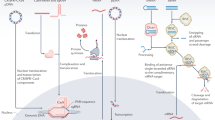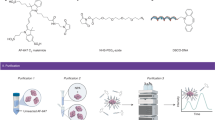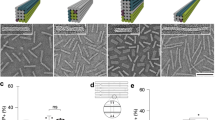Abstract
The goal of gene therapy is to introduce foreign genes into somatic cells to supplement defective genes or provide additional biological functions1,2, and can be achieved using either viral or synthetic non-viral delivery systems. Compared with viral vectors, synthetic gene-delivery systems, such as liposomes and polymers, offer several advantages including ease of production and reduced risk of cytotoxicity and immunogenicity3,4, but their use has been limited by the relatively low transfection efficiency. This problem mainly stems from the difficulty in controlling their properties at the nanoscale. Synthetic inorganic gene carriers have received limited attention in the gene-therapy community, the only notable example being gold nanoparticles with surface-immobilized DNA applied to intradermal genetic immunization by particle bombardment5. Here we present a non-viral gene-delivery system based on multisegment bimetallic nanorods that can simultaneously bind compacted DNA plasmids and targeting ligands in a spatially defined manner. This approach allows precise control of composition, size and multifunctionality of the gene-delivery system. Transfection experiments performed in vitro and in vivo provide promising results that suggest potential in genetic vaccination applications.
This is a preview of subscription content, access via your institution
Access options
Subscribe to this journal
Receive 12 print issues and online access
$259.00 per year
only $21.58 per issue
Buy this article
- Purchase on Springer Link
- Instant access to full article PDF
Prices may be subject to local taxes which are calculated during checkout




Similar content being viewed by others
References
Luo, D. & Saltzman, W.M. Synthetic DNA delivery systems. Nature Biotechnol. 18, 33–37 (2000).
Roy, K., Mao, H.Q., Huang, S.K. & Leong, K.W. Oral gene delivery with chitosan-DNA nanoparticles generates immunologic protection in a murine model of peanut allergy. Nature Med. 5, 387–391 (1999).
Carter, P.J. & Samulski, R.J. Adeno-associated viral vectors as gene delivery vehicles (review). Int. J. Mol. Med. 6, 17–27 (2000).
Pouton, C.W. & Seymour, L.W. Key issues in non-viral gene delivery. Adv. Drug Deliver. Rev. 46, 187–203 (2001).
Yang, N.S. & Sun, W.H. Gene gun and other nonviral approaches for cancer gene-therapy. Nature Med. 1, 481–483 (1995).
Martin, C.R. Nanomaterials - a membrane-based synthetic approach. Science 266, 1961–1966 (1994).
Whitney, T.M., Jiang, J.S., Searson, P.C. & Chien, C.L. Fabrication and magnetic-properties of arrays of metallic nanowires. Science 261, 1316–1319 (1993).
Sun, L., Searson, P.C. & Chien, C.L. Magnetic anisotropy in prismatic nickel nanowires. Appl. Phys. Lett. 79, 4429–4431 (2001).
Wagner, E., Curiel, D. & Cotten, M. Delivery of drugs, proteins and genes into cells using transferrin as a ligand for receptor-mediated endocytosis. Adv. Drug Deliver. Rev. 14, 113–135 (1994).
Laibinis, P.E., Hickman, J.J., Wrighton, M.S. & Whitesides, G.M. Orthogonal self-assembled monolayers - alkanethiols on gold and alkane carboxylic-acids on alumina. Science 245, 845–847 (1989).
Roy, I., Mitra, S., Maitra, A. & Mozumdar, S. Calcium phosphate nanoparticles as novel non-viral vectors for targeted gene delivery. Int. J. Pharm. 250, 25–33 (2003).
Acknowledgements
This work was supported by the Defense Advanced Research Projects Agency (DARPA) and Air Force Office of Scientific Research (AFOSR, under grant number F49620-02-1-0307).
Author information
Authors and Affiliations
Corresponding author
Ethics declarations
Competing interests
The authors declare no competing financial interests.
Rights and permissions
About this article
Cite this article
Salem, A., Searson, P. & Leong, K. Multifunctional nanorods for gene delivery. Nature Mater 2, 668–671 (2003). https://doi.org/10.1038/nmat974
Received:
Accepted:
Published:
Issue Date:
DOI: https://doi.org/10.1038/nmat974
This article is cited by
-
Branched Gold Nanostructures Through a Facile Fructose Mediated Microwave Route
Journal of Cluster Science (2022)
-
Broadening the biocompatibility of gold nanorods from rat to Macaca fascicularis: advancing clinical potential
Journal of Nanobiotechnology (2021)
-
Study on the damage of sperm induced by nickel nanoparticle exposure
Environmental Geochemistry and Health (2020)
-
FeNi nanotubes: perspective tool for targeted delivery
Applied Nanoscience (2019)
-
FeCo nanotubes: possible tool for targeted delivery of drugs and proteins
Applied Nanoscience (2019)



